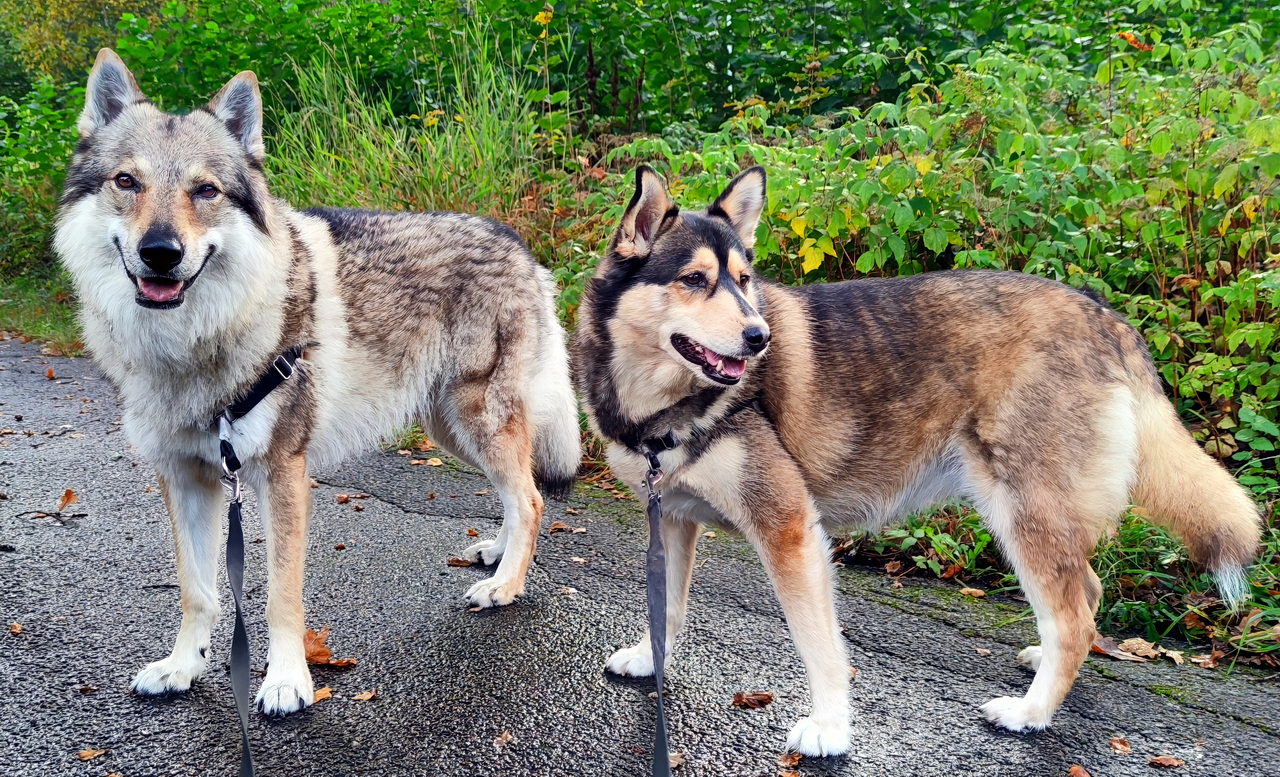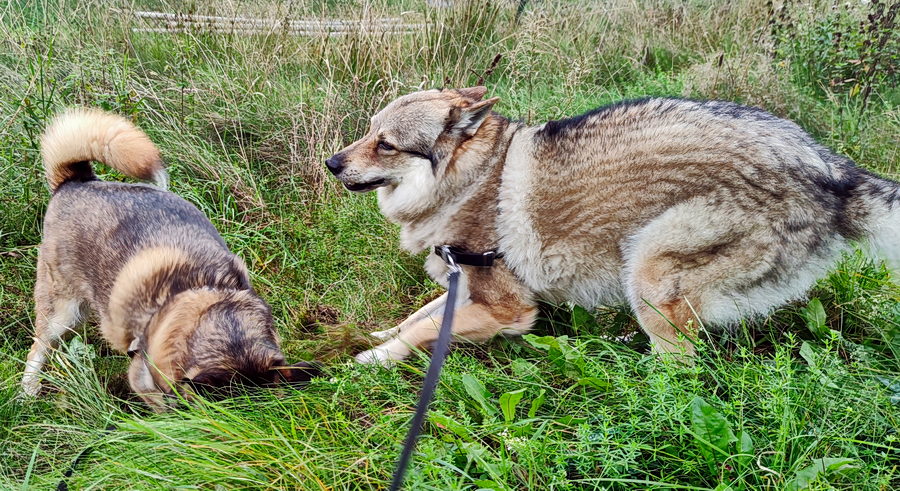As my more ‘personal’ blog-article about our dog adoption got over 1,600 unique hits in the first week after being posted, I decided on a follow-up post as this morning’s article, as there were not many other subjects that caught my attention while doing a quick search anyways.
As you might remember, one of the previous owners who had temporary custody of the almost 5-year-old dog, a Czechoslovakian Wolfdog, visited us on Thursday, September 11, and I decided to take him in with us, either to find him a suitable home or to keep him.
After 1,5 days with him as part of our pack, I decided to keep him. He reminded me a lot of my late Lovec, my previous Czechoslovakian wolfdog, although a bit smaller and not as muscular due to malnutrition (but we’re working on that.) And while Lovec and I could communicate by a single look or by body language, I’m working on that with our new family member as well, and he’s making quick progress.
As he was unregistered and I had his papers and chip-number, it only took a few minutes to get him registered and I also decided to name him Odin, which just for some reason seemed appropriate and a fitting match with his personality.

In my first post, I mentioned his incline to nip or even bite when getting excited and playful. While he, as most dogs, play with his mouth, the biting is now virtually gone, and he only nips carefully and if getting too excited, he winds down as soon as you say ‘stop.’ When I got him, he could actually bite your wrist or hand quite hard and hold it for a while, so we made great improvement from simply putting my fingers in his mouth when he was about to bite to engage the gag reflex and then follow up with positive reinforcement.
As for walking, he had always worn a collar which made him pull extremely hard. Most dogs will do this if not trained properly as pups, due to the feeling of being strangled, and the only way they can think of to get away from that feeling is to escape it by walking faster, as in pulling. A catch-22 moment.
As we got him an easy-walk harness with the attachment on the chest, he walked relaxed after the first try — as the harness gives them absolute freedom of movement. And within a day or two, he walked like a pro. When I give him the full leash, he does his own thing, tracking, sniffing and peeing on things — without pulling on the leash once, and as soon as I shorten the leash, he walks beside me or right behind me.
Also, with the extended leash, if he walks in front of me and is allowed to sniff and pee, a simple nudge with the leash in either direction makes him turn perfectly. The leash is only touching the side of his chest, barely noticeable, but still he understands and reacts accordingly.
My other adopted dog, Shadow, had never walked the leash in her life when I got her at 1-year of age. She was terrified of the collar that they had put on her and tried to hide or lay down behind every thing she could find in our path when trying to walk. But once we came home, I could take her measurements and order an easy-walk harness, and when it arrived the day after, she walked like a pro within 3 days.

Odin also had terrible separation anxiety, as most wolf dogs as the pack is everything. And considering his history of being left home alone by the junkie for more than two days without food and water, I knew this could be a tough challenge. Even with Shadow as company, he scratched the door and made whining noises. But after some training, both with me just outside reminding him that everything was ok, and some real training as when I had to do errands, it disappeared after about 6 days. Now he is calm and quiet while I’m gone, and does not make a sound until I open the door to their own ‘dog room,’ even if I’m home for a few minutes making noises just outside their room.
And while he still barks when he hears people outside our home making loud noises, or slamming doors, it’s not as bad as it was the first couple of days, when he ran around barking and even trying to open the front door to see what the heck was going on. Now it’s more of a low bark and then it’s back to resting or sleeping.
As for his health, it’s rapidly improving. When I got him, his coat was lacking in shine and was more of a stringy mess, like steel wool. Now it’s slowly starting to improve, as his new undercoat is slowly pushing through and he gets a lot of essential animal fats and vitamins in his diet (egg yolks are the best!)
He also lacked muscle mass around his neck, chest and hind legs. But that is also slowly improving as he gets his species-appropriate (obligate carnivore) diet, while getting more versatile exercise, and especially playing a lot off-leash, activating his whole body and doing a lot of explosive movements.
Also, when I got him, both his eyes were runny, leaving a watery mess all the way down to his mouth. After the first week, the right eye had pretty much cleared up. And now, after about two weeks, the left eye is also getting a lot better, only getting slightly watery every now and then. Likely this was from an impaired gut-eye axis. The gut and eyes are connected through the enteric nervous system. A poor diet (as in dry food and/or treats) can disrupt this axis, leading to altered gut microbiota and increased toxin production, which may be excreted through the eyes, causing discharge. And a bad diet, high in toxins, as with all dry food/kibble garbage, can lead to an increased production of reactive metabolites that can accumulate in the eyes, causing inflammation and discharge.
Also, a diet lacking in essential animal fats can increase oxidative stress, causing an imbalance in the tear film’s composition and potentially resulting in runny eyes. So, now as he is getting his species-appropriate diet, it should eventually clear up.

And as for his food, he gets a BARF-mix as a base, which simply is a mix of muscle meat and organ meats. To this, I add on rotation either some extra tallow, ghee, bone marrow, eggs, kefir, and/or extra liver. Once in a while, they might get some other parts of an animal and even some fish.
As Odin was malnourished, he got most of this every day the first 10 days. As of now, it’s the BARF mix and one or two of the above.
Also, twice a week they both get marrow bones for teeth health (cleaning and strengthening,) while getting some extra high quality fat and minerals.
And usually, I also fast my dogs once a week or every other week to aid in detoxification and healing.
As for other dogs, Odin is pretty well-behaved. As with most larger dogs, he’s not too fond of small to medium sized black dogs that has been breed beyond recognition, such as the French Bulldog, or overly groomed and weird-looking dogs like poodles, as these are challenging to read and to determine what they actually are — and if they are dangerous, a threat or friendly.
This is actually the same with people, and why some dogs will react to certain people, especially if they are difficult to read due to wearing a hoodie or some kind of burka, especially if dark-skinned and they dress in black or dark colors (and it’s dark outside,) or if they behave strangely, as with intoxicated people or people who are afraid of dogs, which dogs usually interpret as weird and dangerous behavior. And dogs are very good at reading energies and their sense of smell can catch perspiration due to an adrenaline rush from, for example, stress, anxiety, or aggressiveness. So, if you get afraid and anxious when meeting a large dog, that dog might perceive your smell as actually being aggressive and a threat to the pack.
So, it’s not the dog’s fault if he or she stares, or even makes guttural warning noises, towards someone. It’s all instincts and to keep their pack safe from potential danger.

Odin, as all wolfdogs, will never start a fight. They will only leash out in defense if attacked, and usually to push down and dominate the other dog without any biting. And on September 21, our ninth day, I got to experience this with Odin. We had met up with two elderly friends and their female Finnish Lapphund for a walk. However, they had promised to bring another dog, a Labrador and Golden mix breed that is a bit aggressive towards other male dogs. So, we kept a bit of distance to simply condition him to be part of a pack. And although he looked at Odin several times, trying to leash out with his back fur on end, it went well. Odin only wagged his tail when they met and then ignored him during the walk.
On the way home, however, this dog managed to pull away and jumped on Odin. Odin only defended himself for a few seconds by keeping his mouth open and pushing with his chest until I could grab them both. And one stare, making eye-contact with the other dog, was all that was needed to calm him down. As a dog owner (leader,) you have to be calm and assertive, showing them exactly what is right or wrong, or what to do or not do. You can not get angry, scared, or frustrated. That will send the wrong messages, and a dog will only respect a strong, firm, and calm leader — not someone who contradicts him- or herself by mixing emotions with the wrong body language.

So, the next time Odin and the Labrador-Golden mix met for a walk, the other dog was much calmer and we could stand within 2 meters of each other and chat while the dogs relaxed on the ground. So, in short, Odin behaved very well considering everything he’s been through.
And that is it for this morning. We’re very happy to have Odin as a part of our family, our pack. A lot of fun adventures awaits us. And I will likely do some videos soon.
If you enjoy my free information, please consider donating to help pay the webhosting bills and keep the site running. And if you’re interested in discussing and sharing information with likeminded people, consider joining our uncensored community at Ungovernable.se. Thank you!

